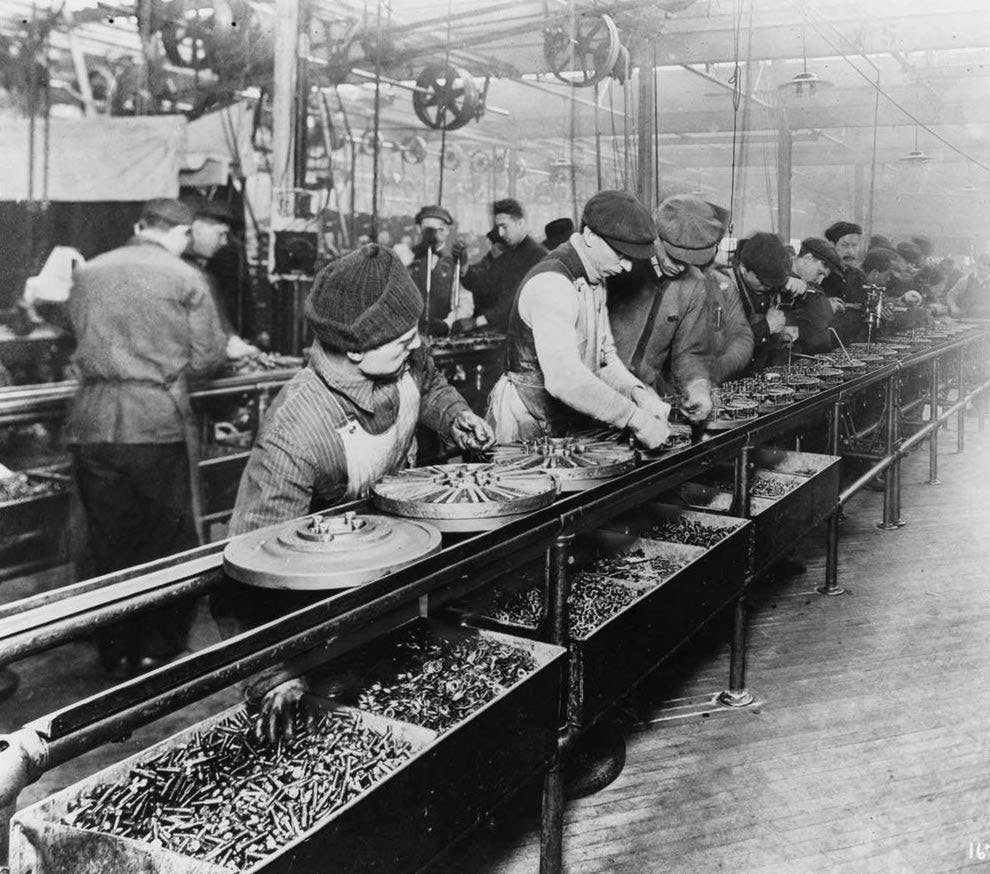The Assembly Line

In a perfect world an NHL team’s amateur procurement and development system works like an assembly line. It’s something the Oilers have been hit-and-miss with up front, but pretty good at in recent years on their blue line.
At any given point in time, there should be prospects at various stages of development, which we can divide into three broad categories:
- new faces still outside the pro system (junior, college or Europe) awaiting entry-level deals and spots on the 50-man list
- inexperienced pros, taking up depth roles on the farm team
- ready or nearly ready prospects, players just waiting for the opportunity to prove they can graduate to the NHL level
Draft picks are the obvious source of supply for such a system, but undrafted players can be important cogs in it, too. In many cases, smart signing can compensate for a system which isn’t producing enough NHL-ready talent.
The value of such an assembly line is that it produces cost-controlled NHL players. With the exception of non-star players taken early in the draft, these young players are generally bargains on their entry-level deals, and sometimes for much longer than that.

Oscar Klefbom is a good example. His entry-level contract had an average annual value just north of $1.2 million, and as with all ELCs had a relatively small AHL salary. He was cheap labour in the AHL, and an almost immediate bargain in the NHL. Then he signed a seven-year extension with the Oilers at a $4.167 million cap hit. Barring trade or serious injury, Edmonton is going to have him for a full decade for much cheaper than the equivalent player would have cost in free agency.
Klefbom’s a high-end outcome, but there’s value elsewhere, too. Tweeners like Anton Lander and Tyler Pitlick add depth to the organization. Young third-pair defenders and fourth-line forwards and backup goalies are as a rule cheaper than older ones.
Having a constant stream of these players working their way up gives an NHL team flexibility. Sometimes it’s the flexibility to walk away from an expensive veteran on a pricey deal. Sometimes it’s the flexibility to trade a still-young player to another team to address a roster need elsewhere.
I thought of the value of the assembly line when I read one of the notes in Al Mitchell’s game day post today:
The signing of William Lagesson this week further adds to the impressive group of young defensemen who will be bubbling under come the fall. Caleb Jones and Ethan Bear will turn pro with Lagesson this fall, and CHL free-agent signing Ryan Mantha will join too. Add in Ziyat Paigin (who has signed an ATO but not his entry-level deal) and we are talking five substantial prospects arriving at the same time. With Oscar Klefbom, Adam Larsson, Darnell Nurse and Matt Benning already in the NHL, the Oilers are going to be very strong at the position. That means great depth, and it also means possibly dealing from a position of strength in trade.
That adds five new players to the Oilers’ system. All of them are probably ticketed to the AHL to start.
Bear and Jones only turn 20 this summer, and it generally takes some time to learn to defend in the NHL, especially for defenders who don’t have size on their side. Mantha is bigger and older but was passed over in the 2016 Draft after the Rangers declined to sign him; he’s obviously had a breakthrough year but expectations should be kept in check. Nothing in Lagesson’s resume suggests he’s knocking on the door of NHL employment at this moment in time. Paigin is a bit of a wild card, but given his difficulty in hanging on to a spot with Ak Bars Kazan some AHL time looks like a good idea.
Yet there’s room for those five in the system because Bakersfield is going to graduate a bunch of players.

Griffin Reinhart, Jordan Oesterle and Dillon Simpson will all need to clear waivers in the fall; my guess is that only Simpson returns to Bakersfield. Mark Fayne is an obvious buyout candidate. Joey Laleggia is now a forward. David Musil is only technically in the organization; Mark Fraser is merely journeyman depth.
Keep Simpson and Ben Betker, add a veteran NHL/AHL ‘tweener for depth and stability, and that’s an eight-man AHL rotation already.
The graduation of Reinhart and Oesterle will force the Oilers to make some decisions at the NHL level. The trade of Brandon Davidson had been offset earlier on by the stunning rookie performance of Matt Benning, and the idea of running all of Benning, Reinhart, Oesterle and Darnell Nurse on a team which should (seriously) be a Cup contender doesn’t seem like a good one.
The expansion draft will figure in here, but it wouldn’t surprise me even a little if the Oilers used Reinhart as a replacement for Eric Gryba and dealt Oesterle to a team in need of defensive depth post-expansion.
This is exactly how it should work. New prospects should constantly be entering the system, flushing away the failures and replacing the graduating success stories. Graduating prospects in turn should be giving the parent team hard choices—and the flexibility that comes with hard choices—at the NHL level.
The Oilers aren’t quite there yet when it comes to forwards, but they’ve been producing defencemen with regularity. Reinhart and Oesterle are following on the heels of Benning, Davidson, Nurse, Klefbom and Martin Marincin since the 2010 Draft. That’s a pretty nice group of homegrown NHL defencemen in a seven-year span.
Recent articles from Jonathan Willis





